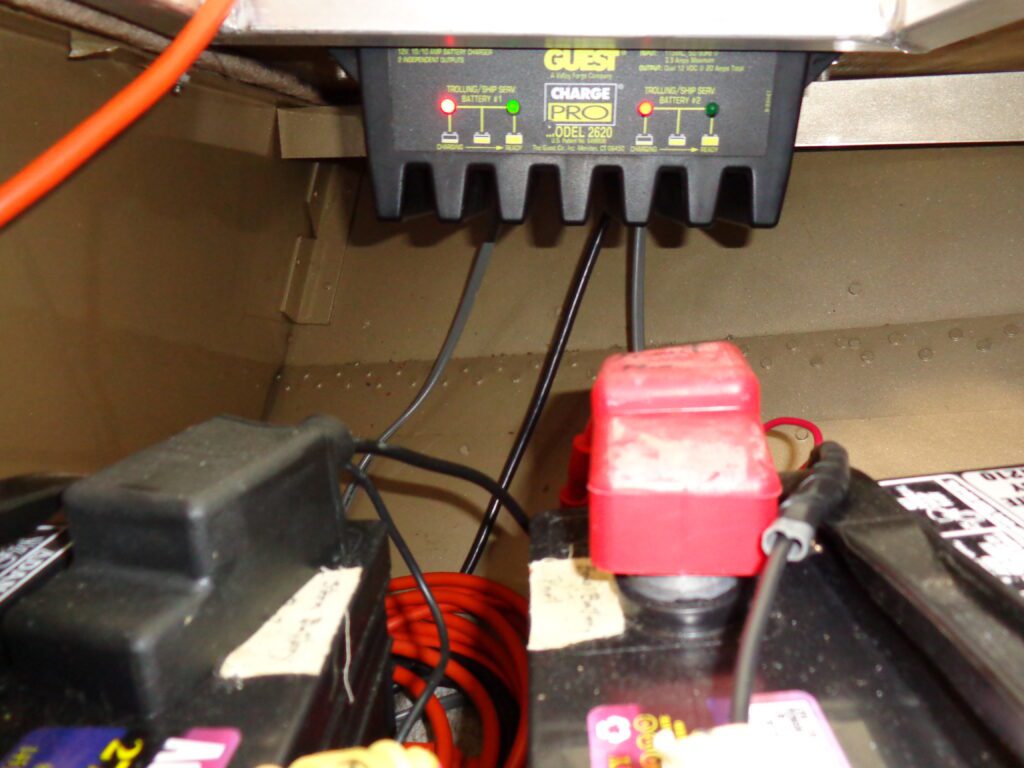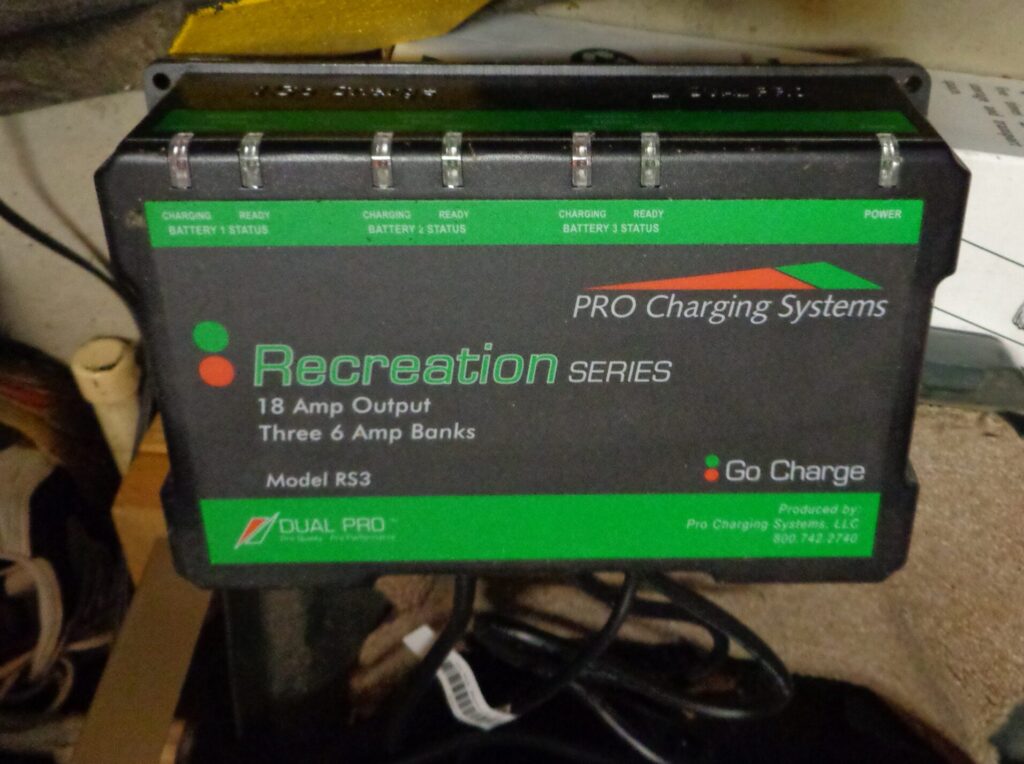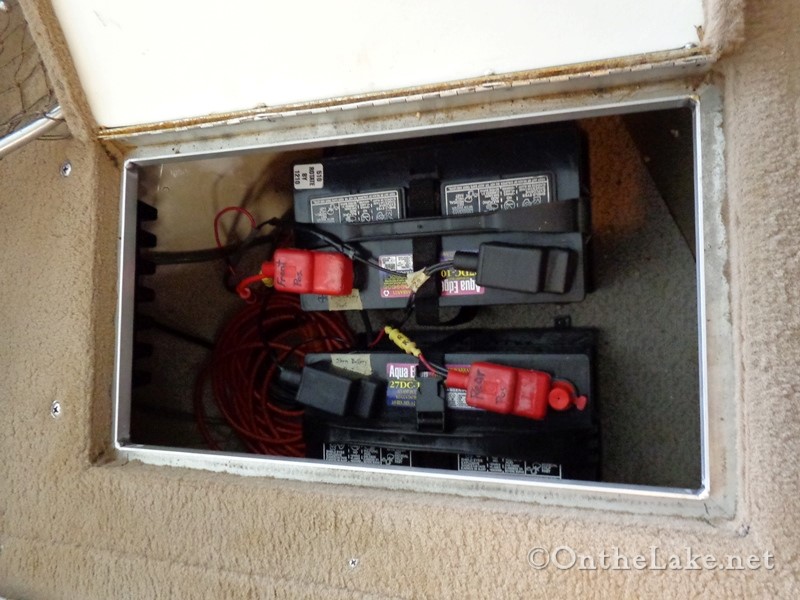Charging boat batteries is much different from charging car batteries. This is especially true today. Importantly, marine batteries, no matter the type (flooded wet cell, gel, AGM, or even the newer Lithium-ion variety, respond to charging in different ways. Using the right battery charger in the proper way will help preserve the life of your boat’s batteries.
(This page may contain affiliate links, which means I may earn a small commission if you click through and make a purchase. You can read our Affiliate Disclosure here.)
Charger Types
Most chargers that were designed to charge your car batteries were not designed to charge your boat batteries… for numerous reasons. For one thing, many chargers — especially the less-expensive ones – don’t always completely shut down. And how often do you think that you can remember to unplug that inexpensive charger when things “look about right?” Importantly, buying a low-cost charger with limited charging capabilities will shorten the life of your batteries rather than prolong them. So, what is the best charger to buy in order to keep those expensive marine batteries in top shape?
There are two types of chargers to consider: portable or onboard. Portables are great for many applications. This is especially true when your batteries are at home and/or if they are out of the boat. These chargers also tend to be a bit less expensive than onboard models. The primary disadvantage of portable chargers is that they can be somewhat inconvenient to hook up and switch from battery to battery in the confines of a boat’s battery compartment. And because they are portable, they are more subject to being stolen if you need to use them in places like motel parking lots, boat stalls or other public places.

Onboard chargers, although more expensive, can easily help pay for themselves when it comes to convenience. Since your whole system is already wired, simply plug it in to a 120-volt outlet and let the charger do the work. Because it’s permanently installed, it certainly deters would-be thieves from helping themselves… Perhaps most importantly, on-board chargers are generally more technologically advanced units. They provide the necessary multi-stage switching to manage and maintain a boat’s batteries during charging. I’ll therefore center the discussion around onboard chargers. Specifically, the desired variety is a multi-stage charger.
Multi-Stage Charging
Leaving behind most of the chemistry and physics involved, batteries will do best on a regulated diet of amperes and volts served up in the right amounts. Current battery charging technology relies on computer chips (microprocessors) to do the job. This is done in stages and there are usually three of them: 1) bulk, 2) absorption and 3) float. The chargers engineered for the staging tasks are referred to as “smart chargers”, designed to provide maximum charge benefit with minimum observation on your part.
Bulk Stage
In the bulk stage, which involves about 75-80% of the recharge process, the charger delivers as much current as it is capable of safely doing – up to charger capacity. This is done at a constant rate while the voltage in the battery is increasing.
Note: This ampere amount could be anywhere from 10 -25% of the battery capacity in amp hours and should not raise a wet battery temperature above 125° F, or an AGM or GEL (valve regulated) battery over 100° F.
Absorption Stage
The absorption stage is where the voltage is now constant, but the amperage is tapered and regulated while the battery is “topped off”. This constitutes roughly the remaining 20-25% of the charge, and the battery should now register anywhere from 14.1 volts to 14.8 volts.
Depending on something called a “set point” in the charger, the current must be varied in a precise way in order to hold the voltage constant (at, for example, 14.4 volts). This takes place while the battery absorbs the remaining energy to reach a fully-charged state. (Otherwise, under- or overcharging could occur),
Float Stage
And finally, the float stage is where the voltage is just enough to keep the battery from losing any charge. The charging current has dropped back to almost nothing, allowing the battery voltage to drop back to around 13.5 volts – 13.8 volts. The neat thing is that, since the battery is now fully charged, this “float” mode can be used to maintain a fully charged battery indefinitely.
Smart, multi-stage chargers are designed for faster and fuller charging, which ultimately leads to longer battery life. It also allows more useable capacity from your batteries, less electrolyte loss (in the case of wet flooded batteries), and/or very little chance of over-charging and ruining sealed batteries.
The Right Charger
Opinions differ on the “right” charger. Recommendations for charger size range from 10% up to 25% of the battery’s amp-hour rating. Bottom line? The higher the charger ampere rating, the quicker the recharge time. Recharge time can be approximated by using a fairly simple formula. Divide the number of amp-hours to be replaced by 90% of the rated output of the charger.
How it Works
As an example: Say you have a 100 amp-hour battery that has been discharged by roughly 50 percent. You would therefore need to replace 50 amp-hours. Using a 10-amp charger, take 50 amp-hours and divide by 90% of 10 amps (or 9 amps). This results in an approximate 5.6 hour recharge time.
A deeply discharged battery deviates a bit from this formula, requiring more time per amp-hour to be replaced. A 6-amp charger would require over 9 hours, while a 15-amp charger would take less than 4 hours to replace the 50 amp-hours of charge.

I have a Dual Pro Recreation Series Triple Output Charger in my garage with three 6-amp banks to use at home over the winter (when time isn’t an issue). I connect my one cranking and my two deep-cycle batteries to that charger.
There is also an onboard charger in my boat. That one has two 10-amp banks just for my trolling batteries (two 12-volt batteries for the 24-volt system) that I use over the summer at the dock.
Note: The Recreation Series charger is now known as the Real Pro Series.
In terms of the right charger, the decision is obviously yours. It depends on your needs and how much you want to spend. Higher amperages and more charging banks add more to the price. Also keep in mind that longer charge times require lower currents in the bulk stage and are a bit gentler on the batteries.
If you like quick charge times, I recommend the Dual Pro Professional Series 2-Bank Charger, 15-amp/Bank PS2. Dual Pro Chargers – Professional, Sportsman and Eagle Performance Series is Made in the USA!
Whatever your choice, a good charger is important in maintaining healthy batteries.
See you On the Lake!








